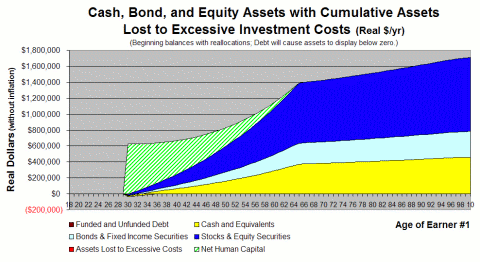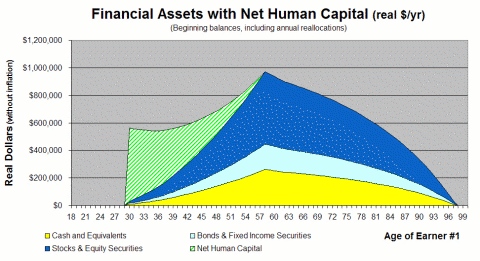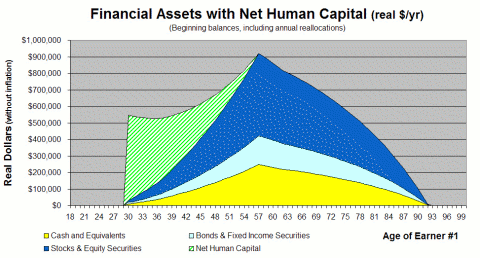Early Retirement for Renters -- due to investment cost improvements and higher savings rates
Improving on Fran and Fred's lifetime financial plan with earlier retirement
Fran and Fred Frugal, both age 30, are a married working couple with $100,000 in combined annual earned income. They want to understand how valuable different personal finance strategies could be to their lifetime finances and their retirement security. In their baseline projection scenario, they planned always to rent, not to have children, to retire at age 65, not to use any tax-deferred investments, and to pay average investment costs.
Obviously, in this baseline scenario Fran and Fran have NOT adopted many of the lifetime financial planning practices that would make it easier to achieve financial success in life. See the "Fran and Fred's Baseline Lifetime Planning Assumptions:" section at the bottom of this article for more information about Fran and Fred's current personal finances and their other lifetime financial planning assumptions.
In a series of articles, The Skilled Investor will compare different lifetime financial planning projections for Fran and Fred to illustrate the relative value of adopting different financial planning strategies.
When Fran and Fred adopt a lower cost investment strategy, they can also explore the tradeoffs between a lower savings rate and earlier retirement.
When Fran and Fred adopt what they consider to be lower, more reasonable investment costs, their projected lifetime finances improve dramatically. The following scenario graphic projects their lifetime assets using lower investment costs.

For more information about their lifetime financial plan with reduced investment costs, see: "Lifetime investment assets of renters -- with investment cost improvements"
In their baseline lifetime financial plan, Fran and Fred do not plan to have any children. While they could change their decision about having children, when they looked at the chart above, they realized that they did not need to build up all these assets without someone to pass them to.
Note that their baseline lifetime financial plan is described in the article entitled: "Retirement Savings Needs of Renters -- prior to any financial planning improvements."
Therefore, in this scenario Fran and Fred want to understand better their early retirement options. In their savings rate comparison scenario, "Pre-retirement Savings Rates for Renters -- with and without investment cost improvements," Fran and Fred found that they could cut their pre-retirement savings rate by about six percentage points each year and still have their projected financial assets last until they were age 95. That meant they could spend about $6,600 more every year due to the savings achieved by reducing their investment costs from "average" to very low.
However, Fran and Fred think that $53,050 per year is enough to live on in "real dollar" or constant purchasing power dollars throughout their lives. Therefore, instead of spending more and both working until age 65, they want to test how much earlier they could retire while having a level $53,050 annual real dollar expenditure rate across their lives.
How much earlier could Fran and Fred retire?(Remember that this $53,050 is for their rental housing and other ordinary living expenses. It does not include their savings, current debt payoff, and taxes over their lives. The remainder of their $100,000 in gross income would cover taxes, debt payoffs, and taxes up until retirement. Thereafter, in retirement, income from Social Security and their taxable asset accounts would pay all their living expenses and taxes.)
To find out the answer to this question, Fran and Fred modeled lifetime annual expenditures at $53,050 and used their low cost investment assumptions, which were detailed in the article: "Lifetime investment assets of renters -- with investment cost improvements." Then, they quickly ran a series of scenarios to test some lower retirement ages. They wanted to find an earlier age that they might be able to retire, yet still have enough financial assets until age 95. Their results can be found in the graphs below.

This graphic above projects how long Fran and Fred's assets would last, if they both retired at age 58. With retirement at age 58, their assets could last until they were midway between age 97 and 98. (This dollar information comes from the data tables that the model automatically generates for all graphics, whenever any projection scenario is run.)
When they ran another scenario with their retirement set to age 57, their financial assets graphic looked like this:

For an age 57 retirement, their financial assets would run out soon after they reached age 92. The difference between the two charts above indicates that roughly an extra year of work during Fran and Fred's fifties would "buy" them about an extra four to five years of living expenses during their twilight years.
When Fran and Fred develop lifetime projection scenarios by changing retirement ages, they make yearly changes. One extra year of work covers their expenses from age 57 to 58, and therefore these expenses in that year do not deplete their accrued assets. In addition, they have one more year of savings to add to those assets. These factors combined with several decades of subsequent asset appreciation turn an extra year of work into 4 or 5 years of expense coverage in their late retirement.
Note: To reduce the number of variables that they were changing at one time, Fran and Fred did not adjust their expenditures during the years of their early retirement up until age 65. However, this would have been relatively straightforward to model. For example, if Fran and Fred had received valuable additional benefits through work, such as company-paid health insurance, they could simply plug those extra costs into the model during their early retirement years. If the value of these benefits were substantial, then this situation could reduce somewhat their opportunity to take early retirement. (For example, if they retired at age 58 and their lost work benefits that were worth $8,000 per year for 7 years, or $56,000, then their assets would run out about three years earlier than the projection graphic above would indicate.)
Finally, we used the term "precision" on quotes above. Fran and Fred's projections are just scenarios about what could happen rather than what will happen, since the future is completely unpredictable. The real purpose of systematic personal lifetime financial modeling is to explore automated financial planning scenarios that are internally consistent and that reflect your current financial circumstances and expectations. Planning models are useful for deciding whether you want to change your current financial behaviors in light of what the projections tell you about your possible future circumstances.
For more on this subject, see these 17 "Financial Decision Rules" articles on The Skilled Investor's main website. In particular, read this article under this financial decision rules category: "No financial planning software and no investment growth calculator can predict the future."
VeriPlan lets you focus on your own particular financial needs, circumstances, and goals. VeriPlan is the most powerful and sophisticated do-it-yourself financial planning software available to you.
As a fully integrated lifetime personal financial planner, VeriPlan automatically and instantly projects annual values over your lifetime for your family's income, living expenses, debts, taxes, taxable and tax-deferred assets, and property. Every VeriPlan lifetime projection presents your personalized financial information net of your federal, state, and local taxes and your investment costs.
Fran and Fred's Baseline Lifetime Planning Assumptions:
Fran and Fred Frugal, now age 30, are a married working couple with $100,000 in total annual earned income. Their major lifetime financial planning goals are to have enough financial assets until at least age 95, in case both live that long. These are Fran and Fred's major baseline projection assumptions.
NOTE: Of course, some of Fran and Fred's assumptions are not optimal. In various scenarios, we will change these assumptions to illustrate the relative value of improvements.
Fran and Fred expect the following:
WORKING INCOME: Both intend to work full-time, until retirement at age 65. (IN THIS SCENARIO, THEY TEST RETIREMENT AGES PRIOR TO AGE 65.)They expect their earned income to grow with the rate of inflation.
RETIREMENT INCOME: They expect to collect 60% of currently quoted Social Security retirement benefits. They do not expect to have any pensions.
LIVING EXPENSES: They expect that their living expenses, before and after retirement, will grow with the rate of inflation. They plan always to rent and never to buy their residence. They do not plan to have any children. They expect that their retirement living expenses with be the same as their living expenses, when they were working.
DEBTS: They plan to pay off their current $20,000 in educational debts and $15,000 in credit card debt, as required by these debt contracts. Then, they plan to remain debt free throughout their lives.
TAXES: They plan to file income taxes using standard tax deductions. They expect always to live in Massachusetts, a state with a 5.3% flat income tax rate.
INVESTMENT STRATEGY: They now have $10,000 in money market funds, $10,000 in bond funds, and $10,000 in stock funds. They expect to use an average investment strategy with an average asset allocation throughout their lives. (IN THIS SCENARIO, THEY USE LOW COST INVESTMENT STRATEGIES.) They intend to hold only money market fund, bond fund, and stock fund investments. They hope to earn very long-term historical asset class investment rates of return. They plan to pay average investment costs. They intend to buy-and-hold very broad market index funds, to withdraw assets only to meet expenses, and to pay long-term capital gains tax rates, as much as possible.
TAXABLE versus TAX-DEFERRED ACCOUNTS: They expect to use only taxable investment vehicles and do not plan to use any tax-advantaged retirement accounts.
